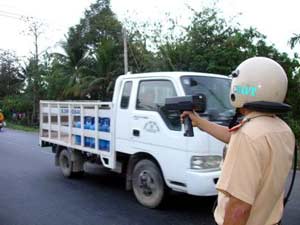For the first time in Vietnam, after two years of research, a team from the Vietnam Measurement Center, in collaboration with the Vietnam Road Administration and the Institute of Transportation Science and Technology, has successfully designed and manufactured a dynamic control system to monitor overload and speeding of road vehicles. The product, installed on road traffic routes, will be effective in monitoring even while vehicles are in motion.
 |
|
(Photo: VNN) |
Speeding vehicles have become a common issue in Vietnam. This is the main cause of the degradation and even damage to the current road system, posing potential accident risks.
Meanwhile, to control the situation of overloaded and speeding vehicles, many countries around the world have implemented dynamic monitoring systems using various effective technological solutions.
Drawing from these real-world models, the research team at the Vietnam Measurement Center has proposed a project to design and manufacture a dynamic control system branded as VN, with the goal of: designing a system suitable for the specific conditions of Vietnam’s roads, reducing costs compared to imported systems, and, importantly, mastering the technological solutions in the design and manufacture of the product. After two years of research and testing, the system has refined its features, allowing for accurate control of the weight and speed of vehicles on the road, meeting the technical standards corresponding to systems used in the region.
Master Dao Duy Hung – Head of the Mass Measurement Department at the Vietnam Measurement Center stated: “Previously, we had static monitoring systems; however, there were some limitations, so we chose dynamic weighing to overcome those issues. This dynamic weighing system can monitor 100% of vehicles that static scales cannot check. Secondly, this system automatically calculates data and provides results without relying on human subjective factors.”
The main design of the system includes: sensors installed on the road, consisting of position sensors and load sensors. When a vehicle passes the sensor location, the received signals are immediately sent to the automatic signal analysis and processing unit, providing accurate results regarding the load on the vehicle’s axles, the distance between axles, total weight, and speed of the vehicle as it passes through the system.
A software interface in Vietnamese allows for system management and control; it also enables the input and storage of necessary data for management purposes, such as vehicle groups, lanes, and passage times, etc.
With a management mode through cameras, the system can automatically capture images of violating vehicles at a rate of up to 30 images per second, even when vehicles pass the device at speeds of 50 km/h, with the images remaining very clear. Currently, this system can manage up to 8 lanes simultaneously and can capture images of vehicles traveling in both directions. These images will serve as a basis for statistics and reports on vehicle violations throughout the day. However, the characteristics of our road system are quite complex and not yet segregated, so the research team is still seeking the best solutions to handle noise factors.
Establishing a dynamic monitoring system on Vietnam’s roadways will create an effective control network, helping to collect data on road conditions, providing a basis for investment decisions, upgrades, and the construction of new traffic routes, avoiding wasteful investments, while also significantly improving the control and handling of violations, contributing to the enhancement of traffic management in Vietnam.


















































